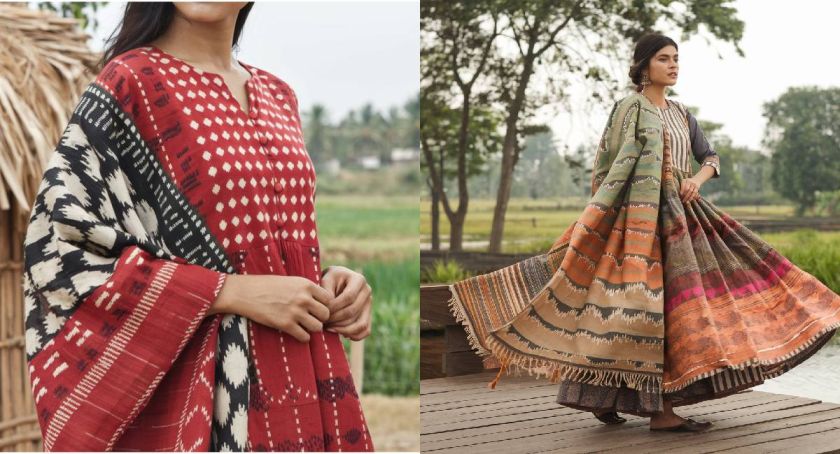Odisha Handwoven Dresses Lead Sustainable Fashion Revolution
In today’s fast-paced fashion industry, sustainability has become a buzzword. As the world faces growing environmental concerns, the need for eco-friendly alternatives in fashion has never been more urgent. In the middle of this, the eastern Indian state of Odisha, with its long history of handwoven fabrics, is a shining example of sustainable design. Odisha’s handwoven garments, renowned for their outstanding quality, elaborate designs, and environmentally friendly production processes, are more than simply a fashion statement; they are a sustainable option supporting artisans’ livelihoods, culture, and environment.
The Legacy of Handwoven Textiles in Odisha
Odisha has long been a hub for handwoven textiles, dating back centuries. The state has diverse weaving traditions, including Ikat, Bomkai, Khandua, and Sambalpuri. These textiles are crafted with skill, dedication, and a deep understanding of the natural world. In contrast to mass-produced clothing, each piece of fabric is painstakingly handwoven, utilizing methods passed down through the years.
The most significant characteristic of Odisha’s handwoven fabrics is their use of natural fibers and dyes. Cotton, silk, and other locally sourced materials are often chosen for their durability and eco-friendly properties. This focus on sustainable, locally sourced materials sets Odisha’s handwoven dresses apart from fast fashion, which relies heavily on synthetic fibers and harmful dyes.
Eco-Friendly Production Methods: A Step Towards Sustainability
One of the most notable aspects of Odisha’s handwoven dresses is the low environmental impact of their production. Unlike large-scale textile mills, which consume vast amounts of water, energy, and chemicals, handweaving is a more sustainable process. Here’s how:
- Minimal Water Usage: Compared to industrial textile mills, which use large quantities of water to dye and finish fabrics, handweaving uses minimal water. The water used in traditional handloom weaving is often reused, making the process far more eco-friendly.
- Chemical-Free Dyes: Traditional dyes used in Odisha’s handwoven fabrics are extracted from natural sources like plants, fruits, and minerals. These dyes are safer for the environment and the health of the artisans who work with them. In contrast, the textile industry’s reliance on synthetic dyes often leads to harmful chemical runoff that pollutes rivers and water sources.
- Energy Efficiency: Handloom weaving doesn’t rely on electricity or fossil fuels. The weavers use manual tools, meaning the production process has little to no carbon footprint. This starkly contrasts with the energy-intensive processes in textile factories.
Preserving the Craft and Culture through Sustainable Fashion
Beyond their positive effects on the environment, Odisha’s handwoven garments are essential to maintaining the area’s rich cultural legacy. Hand weaving is a craft and a way of life for many in Odisha. By supporting these handwoven textiles, consumers are promoting sustainability and helping preserve the livelihoods of thousands of artisans.
These artisans are part of an age-old tradition, and their craft supports local communities. The wages earned by weavers help sustain rural economies, keeping them self-reliant. Many weavers in Odisha belong to socially marginalized groups, and the demand for their products helps uplift them economically. In this way, buying handwoven dresses from Odisha isn’t just an eco-conscious decision; it’s also an ethical one.
A Fashion Statement with Conscience: Eco-Friendly, Yet Stylish
The beauty of Odisha’s handwoven dresses lies not only in their sustainability but also in their unique aesthetic appeal. These garments are known for their vibrant colors, intricate designs, and rich textures, making them stand out in fashion. The vibrant Ikat designs of Sambalpuri saris, the sophisticated patterns of Khandua, and the exquisite Bomkai textiles are perfect examples of the state’s textile brilliance.
Sustainable fashion often sacrifices style for eco-friendliness, but Odisha’s handwoven dresses perfectly balance the two. While wearing a stunning, one-of-a-kind item, customers may feel good about their purchase since they support local artists, the environment, and cultural preservation.
A Step Toward a Greener Future
Odisha’s handwoven dresses offer a remarkable example of how tradition can meet sustainability. With minimal environmental impact, natural dyes, and eco-friendly production methods, these dresses are not just garments; they are a statement about how fashion can be beautiful, functional, and responsible.
By embracing these handwoven creations, we support a centuries-old craft and contribute to a greener future. The world must recognize the importance of sustainable fashion. Odisha’s handwoven dresses perfectly exemplify how eco-friendly practices can seamlessly blend with the art of fashion.


